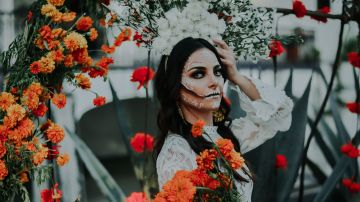5 Facts About the History of La Catrina
La Catrina is an iconic figure, read on to learn more about the history and artistry behind the fame

Photo: Pexels/ Luis Zambrano
When it comes to Dia del los Muertos, La Calavera Catrina, also known simply as La Catrina, is an icon. The female skeletal figure is an enchanting and powerful presence at Day of the Dead festivities, and there’s more to her than meets the eye. There are statues and makeup looks inspired by her macabre and graceful appearance, and while many people are familiar with her image, many are unaware of her origins or symbolism. Here are just a few fascinating facts you may not have known about the notorious Lady of the Dead.
She Has Indigenous Roots

Before the emergence of La Catrina, there was a goddess of death named Mictēcacihuātl who was worshiped by the Aztecs. It’s believed the deity was sacrificed when she was just a baby, matured in the underworld, and married. She guarded the realm of the afterlife with her husband, Miclantecuhtl. Together, they collected the bones of the deceased to give to the other gods so that the dead could be brought back to life and create new races. The Aztecs revered Mictēcacihuātl and historians have discovered they held a special month-long celebration in her honor that possibly included rituals, music, and blood sacrifice.
Aztec drawings portrayed her with no flesh on her body, a skeletal face, and wide-open jaw so she could swallow the stars during the daytime. When the Spanish conquistadors invaded Mexico and tried to eradicate Indigenous customs, they thought they could silence Mictēcacihuātl. However, the natives did not forsake their Lady of the Dead, and the figure morphed over time, blending Spanish Catholic and Indigenous spiritual beliefs and imagery. In essence, the deity is the precursor to the La Catrina we now know.
José Guadalupe Posada Created the Famous La Catrina Image

The familiar image of La Catrina that exists today can be credited to José Guadalupe Posada who was born in 1852. He was a Mexican illustrator and printmaker who created skull characters (calaveras) to make political statements in a satirical way, and his work was published in newspapers and periodicals. He drew La Calavera Catrina in 1910, at the start of the Mexican Revolution, to criticize the rule of Porfirio Diaz and the fixation upper-class Mexicans had with European culture. For her debut appearance, she donned an elegant feathered hat that was intended to mock aristocratic fashion.
She Went by a Different Name
The original name of José Posada’s caricature was “La Calavera Garbancera.” Some sources say the term “garbancera” referred to women who wanted to cover up their Indigenous heritage and assimilate to European culture. Later, it was replaced with “catrin” and “catrina,” which roughly translates to a fancily clad and dapper man or woman. Posada is attributed with saying, “Death is democratic. At the end, regardless of whether you are white, dark, rich or poor, we all end up as skeletons.” His words neatly sum up that in death we are all equal, regardless of status, appearance, or origins.
Famed Mexican Artist Diego Rivera Popularized the Full-Form Catrina

Between the years 1946 and 1947, Diego Rivera painted one of his most influential works, Sueño de una Tarde Dominical en la Alameda Central (Dream of a Sunday Afternoon at Alameda Central Park). The piece depicts 400 years of Mexican history, highlighting key figures and events. At the center of the image is La Catrina, but unlike Posada’s sketch which only shows her upper body, Rivera drew her full form.
She’s dressed in a fancy gown and large decorative hat. The colorful feathered boa draped around her neck is said to represent the Aztec serpent god, Quetzalcóatl. On one side of her stands Jose Posada, on the other is Rivera as a young boy, and behind her is Frida Kahlo. Together, they symbolize the turbulent history of Mexico and embody the indigenous and colonized people. If you look closely, it appears the artist even painted his Dame of Death with makeup, including rouged cheeks and stained crimson lips. It is this rendering of La Catrina that has gone on to inspire the image so many admire and associate with Dia de los Muertos.
La Catrina in Popular Culture throughout Latin America and the U.S.
La Calavera Catrina has become an intrinsic part of Day of the Dead celebrations with the inclusion of sugar skulls on ofrendas and statues made in her image. As her popularity has grown, she’s inspired countless individuals to imitate her appearance. Come November 1st and 2nd, people dress up and paint their faces like her, and there are numerous makeup tutorials showing how to get the look down. Recreations range from simple to ornate but they always feature the iconic skull imagery.
Christina Sanchez, who’s known on social media as Catrina Christina, has been lauded for her stunning representation of the Lady of the Dead and attends many Dia de los Muertos events dressed as the figure. Singer Ángela Aguilar adopted the look in the music video for her rendition of “La Llorona.” She can also be seen in contemporary artwork and tattoos. Films Coco and The Book of Life have popularized La Catrina in the U.S. and helped the tradition grow in popularity in the states and become more mainstream as evidenced in the collaboration with Mexican illustrator Luis Pinto and Target.
La Catrina is significant to many people and bridges the past to the present. She keeps Mesoamerican traditions alive, reminding us of where we come from and where we will return. Her connection to death and the afterlife and radiant presence communicate that while it’s natural to grieve for our loved ones who’ve passed, it’s just as important to celebrate their memories.

















